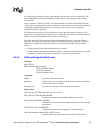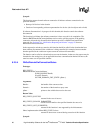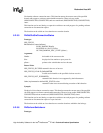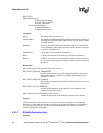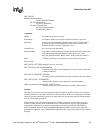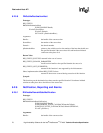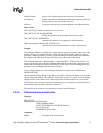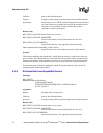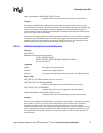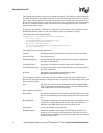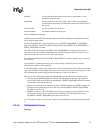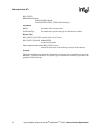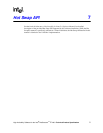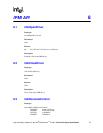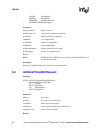
High Availability Software for the Intel
®
NetStructure
TM
ZT 4901 Technical Product Specification 73
Redundant Host API
Other, implementation-defined HSI_STATUS values
returned if other errors occurred during execution of this function
Synopsis:
This function establishes the callback that is called when an attempt is made to take over any
domain from the current host. The callback function is called with the requesting host number, new
owning host number, and the domain number as parameters. Another parameter, pContext, is
passed unchanged from the function that establishes the callback to the callback itself and can be
used to pass some context information.
If the switchover request callback is called, the requested switchover isn’t successfully completed
in hardware until the callback returns. The callback can request the infrastructure to prevent the
requested switchover from happening by returning FALSE. In that case, the infrastructure may
perform hostile actions to the new owning host (for example, power it off).
6.2.6.4 RhEnableUnsafeSwitchoverNotification
Prototype:
HSI_STATUS
RhEnableUnsafeSwitchoverNotification(
IN RH_HANDLE Handle,
IN RH_UNSAFE_SWITCHOVER_CALLBACK Callback,
IN void *pContext );
Arguments:
Handle – the handle of the current session
Callback – pointer to the callback function
pContext – an opaque context pointer; passed unchanged to the callback function.
Return Value:
HSI_STATUS_SUCCESS returned in the case of success
HSI_STATUS_INVALID_PARAMETER
invalid session handle or the specified domain does not exist
HSI_STATUS_NOT_SUPPORTED
returned if this function is not supported by the infrastructure
Other, implementation-defined HSI_STATUS values
returned if other errors occurred during execution of this function
Synopsis:
This function establishes the callback that is called when a new domain is acquired by the current
host. In that case, some (or all) devices in the domain may be in an unsafe state. To prevent
immediate corruption of the new owning host after the switchover, a bus lock is usually
implemented in RH systems. This lock prevents outgoing transactions from the domain devices to
the host and interrupts from the domain devices. However this lock should not be held for a long
time, but should be cleared by software soon after the switchover to allow normal operation of
domain devices.



